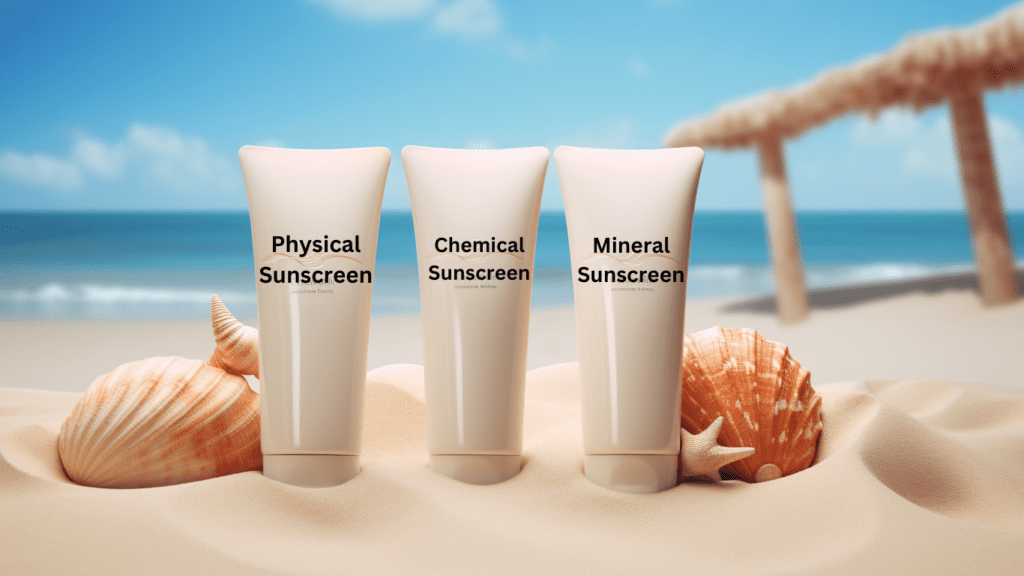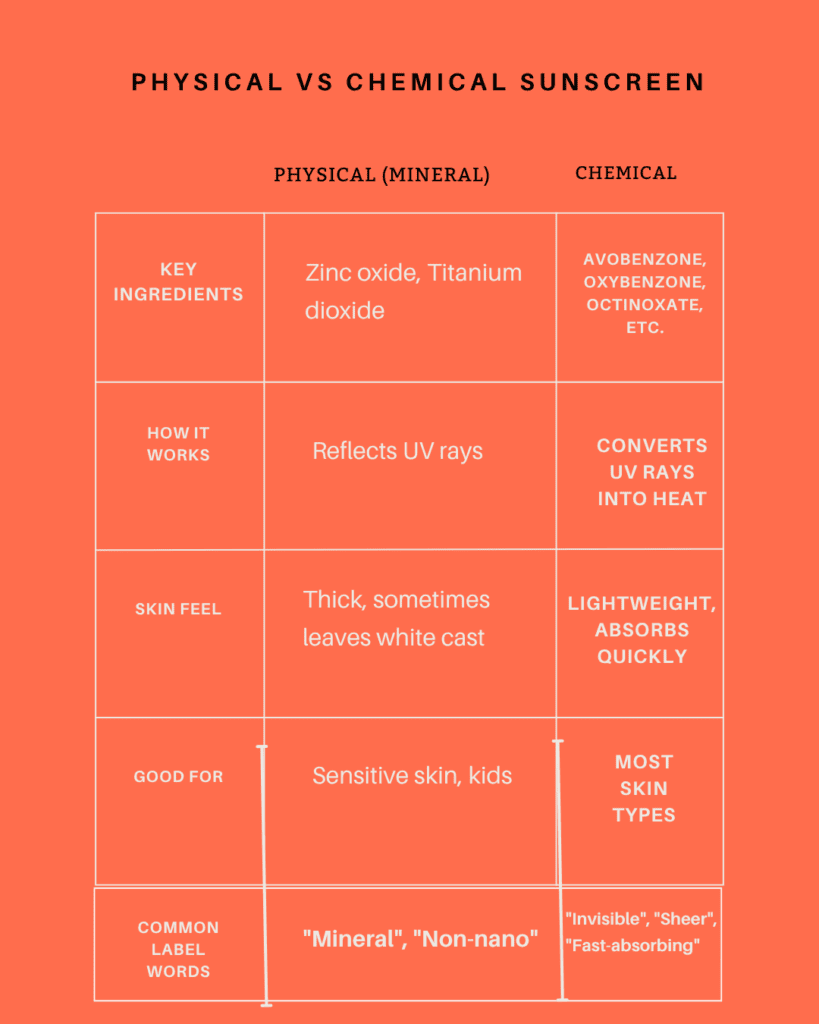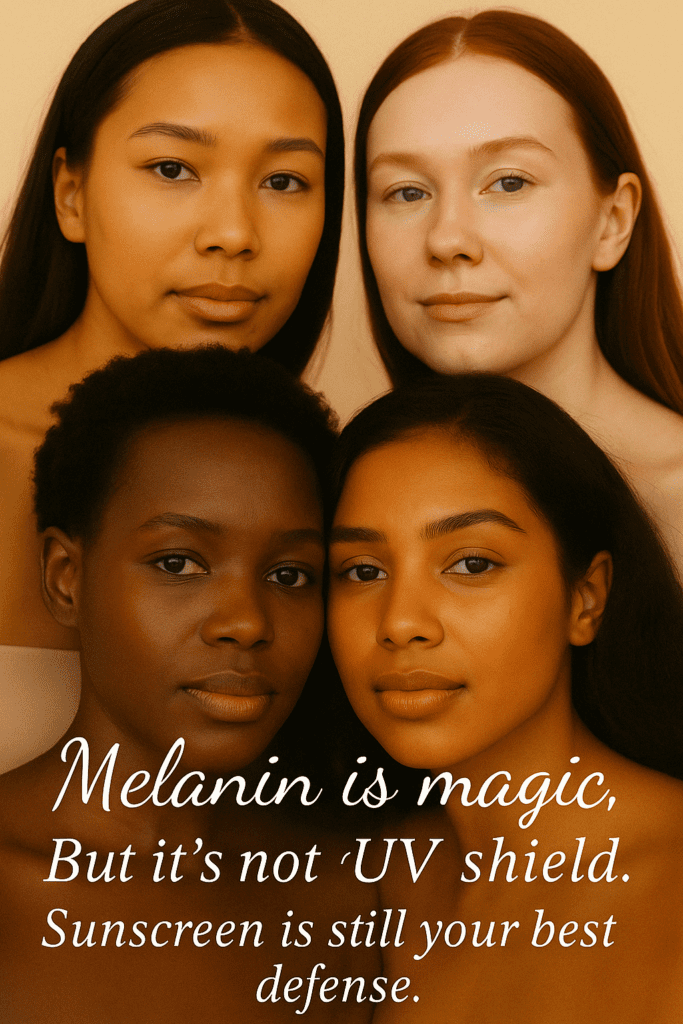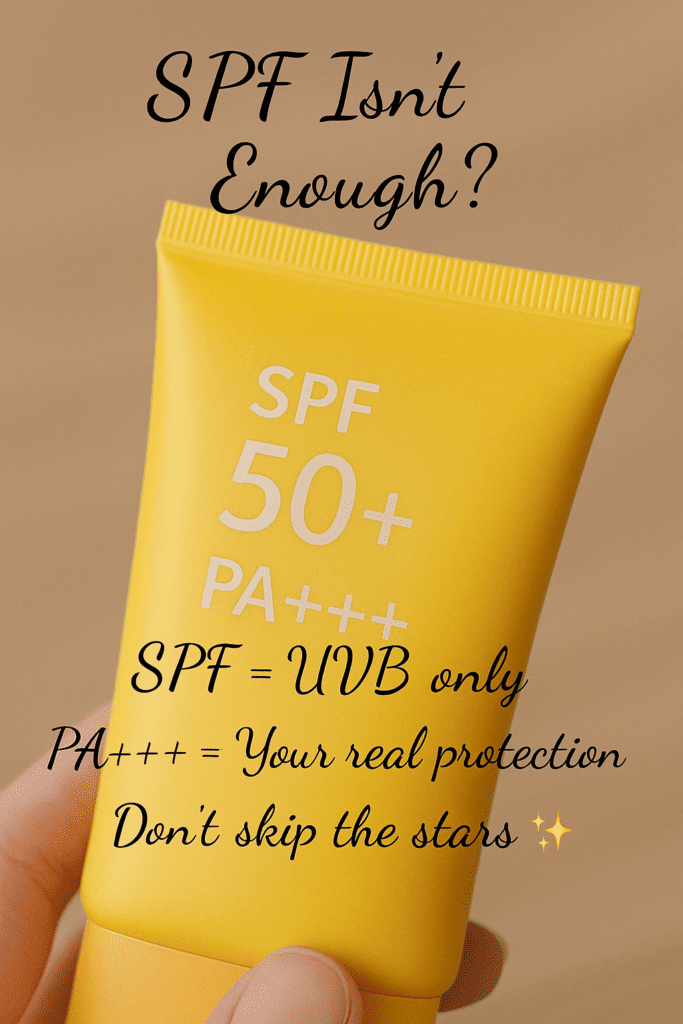✨ New to sunscreen or still confused about SPF and PA+++?
👉 Start with my Sunscreen Basics Guide to understand why sun protection matters — even on cloudy days.

🧴 Not all sunscreens are made the same. Here’s what you need to know:
Physical Sunscreen/Mineral Sunscreen
“Titanium dioxide and zinc oxide are the two most common physical blockers that stop UV light from getting to the skin by reflecting it. Thanks to new manufacturing techniques, these ingredients are now made in a micronized form. This new form scatters the UV light instead of reflecting it, which means it doesn’t leave a visible layer on the skin.”
Chemical Sunscreen
Chemical sunscreens work differently by allowing UV light to penetrate the skin. Once inside, the sunscreen’s chemicals (which include oxybenzone, avobenzone, octisalate, octocrylene, homosalate, and octinoxate as listed by the AAD) trigger a chemical reaction. This reaction transforms the UV light into heat, which is then released from the skin.

Importance of wearing Sunscreen in winter

Sunscreen in winter
Even in winter, the sun can still harm your skin. UVA rays, which cause skin aging, are always present—they can pass through clouds, fog, and even windows. So even if you’re indoors on a cold, sunny day, your skin is still exposed. UVB rays, which cause sunburn, are weaker in winter but don’t go away completely—especially when sunlight reflects off snow. That’s why wearing sunscreen every day is important, no matter the season.
Ultraviolet radiation
UV rays is a type of energy from the sun, travels through space as visible light. Sunlight consists of numerous wavelengths spanning the electromagnetic spectrum. When these solar rays traverse the Earth’s atmosphere, certain wavelengths are filtered out. The remaining wavelengths reach Earth as UV and infrared light. a UV rays are grouped into three categories: Ultraviolet A (UVA), Ultraviolet B (UVB), and Ultraviolet C (UVC), along with some infrared light.
UVA rays
Comprises of wavelengths ranging between 410 and 320 nm and reach the Earth’s surface with constant intensity throughout the day. It penetrates deeply into the skin, damaging collagen and elastin, leading to aging, wrinkling, dry skin, loss of elasticity, etc, UVA rays can penetrate through clouds, fog, and glass windows. Therefore, your skin can still get damaged even on a sunny winter day indoors.. Sunscreens protect against these ultraviolet (UV) radiation and, therefore, against premature skin aging(photoaging) and skin cancer.
UVB RAYS
Wavelengths: 280-320 nm reaches the Earth’s surface with varying intensity throughout the day, peaking around midday. It is partially absorbed by ozone and clouds and does not penetrate glass windows. Although not absorbed as deeply as UVA rays by skin, UVB is responsible for skin tanning ,Sunburn and free radical damage that can cause cell dead.
Treating hyperpigmentation poses significant challenges, and irrespective of its origin, it is crucial to consistently apply a broad-spectrum sunscreen with a PA+++ rating throughout the day. This practice should be maintained regardless of weather conditions—be it sunny or cloudy, in both summer and winter.
Facts about sunscreen
Do I really need sunscreen in winter? Like, the sun isn’t even hot!”
Absolutely yes. Think of UVA rays as sneaky little ninjas—they don’t care if it’s cold, cloudy, or foggy. They’re present all year and go right through windows. So even if you’re binge-watching shows on your couch by the window, they’re aging your skin in the background.
UVB rays (the sunburn ones) do slow down in winter—but not enough to skip protection. Snow reflects UV rays like a mirror, doubling the damage when you’re out for a walk or run.
❓ My sunscreen says SPF 50. That’s good enough, right?
Good—but incomplete. SPF only covers UVB. You also need protection from UVA—the rays that cause pigmentation, aging, and melasma flare-ups.
Look for PA+++ or PA++++ on your sunscreen. That means strong UVA defense. SPF is the bouncer at the door. PA+++ is the full security team.
You’re almost there! Let me clarify it precisely:
✅ What SPF and PA+++ Actually Mean:
🔸 SPF (Sun Protection Factor)
- Protects only against UVB rays (the ones that cause sunburn and direct DNA damage)
- SPF 50 means: it blocks ~98% of UVB rays, not UVA
🔸 PA+++ (Protection Grade of UVA)
- PA rating measures UVA protection only (the rays that cause aging, pigmentation, and melasma)
- The more plus signs (PA+, PA++, PA+++, PA++++), the stronger the UVA protection
❌ Common Misunderstanding:
SPF + PA+++ does not mean you’re protected from UVB and UVA equally.
It means:
- SPF = UVB coverage
- PA+++ = UVA coverage
🔸 SPF = UVB Protection
Blocks UVB rays that cause sunburn and DNA damage. Think: beach day, red skin, and painful burns.
🔸 PA+++ = UVA Protection
Shields against UVA rays that cause aging, pigmentation, and melasma. Think: wrinkles, dark spots, and long-term skin damage.
You need both on your sunscreen label for full protection.
SPF 50 PA+++ or PA++++
This covers both UVA and UVB.
✅ Best Sunscreen Label Example:
SPF 50 PA+++ or PA++++
This covers both UVA and UVB.
❓ How much do I actually need? I just dot it on my face and go.
That’s sunscreen ghosting your skin. Use the two-finger rule: squeeze out sunscreen along your index and middle finger—that’s how much you need just for your face and neck.
Still confused? Think of it like this:
- 🥄 Face = ¼ teaspoon
- 🥃 Body = 1 shot glass (yup, the party kind)
If your bottle lasts six months, you’re underusing it. Sunscreen should be replaced every 1–2 months if you’re using it right.
🧴 How to Apply Sunscreen Properly
Face & Neck: Use 2 fingers of sunscreen (index + middle).
Full Body (in swimwear): 1 shot glass amount — don’t underuse!
On Makeup: Reapply with a spray, powder, or tinted stick.
At Home (window light): 1 layer in the morning is fine.
Outdoors: Reapply every 2–3 hours — especially if sweating or swimming.
❓ I work from home. Do I really need to reapply?
If you’re sitting next to a window, yes—especially if sunlight pours in. Otherwise, one application in the morning is okay. But if you’re stepping out for a coffee, a walk, or groceries, reapply.
❓Dark skin here. Do I really need sunscreen?

Absolutely. Melanin gives you some natural protection, but not a shield. You can still get sun damage, uneven skin tone, and stubborn pigmentation. In fact, sunscreen is key to fading hyperpigmentation on deeper skin tones.
❓ I hate how sunscreen feels. Sticky, greasy… no thanks.
Totally valid. But there’s a formula for everyone now. Want something that feels invisible? Go for a gel-based sunscreen. Need hydration in winter? Use a moisturizing sunscreen. Oily skin? Look for matte-finish or water-based sunscreens.
💡 Pro tip: Tinted sunscreens give added protection, blend easily, and even out your skin tone.
Choosing the Right Sunscreen: Gel, Cream, Matte, or Tinted?
You’re not alone. Sunscreen aisles feel like a skincare jungle.
Here’s how to decode it:
| Skin Type | What to Look For | Why It Works |
|---|---|---|
| Dry Skin | Cream-based, with glycerine | Feels rich, locks in moisture |
| Oily/Acne-Prone Skin | Gel or water-based, non-comedogenic | Lightweight, no clogged pores |
| Sensitive Skin | Mineral sunscreen (zinc oxide or titanium dioxide) | Gentler, no stinging |
| Pigmentation / Melasma | Tinted sunscreen / Physical sunscreen | Adds iron oxide, blocks visible light too |
🛒 Shopping hack: Look for “broad-spectrum” + “PA+++” + “SPF 30 or higher.

How the heck do I reapply sunscreen on top of makeup?
This is the question lady asks.
Options:
- Sunscreen sprays – Light mist over makeup. Easy, but reapply generously.
- Powder sunscreen – Great for oily skin. Swipe like a finishing powder.
- Tinted sunscreen sticks – Swipe and blend on cheeks, forehead, nose.
💡 Reality check: Makeup with SPF is nice—but not enough. It’s like sprinkling SPF on top of a cake. You need the base layer underneath.
Can Sunscreen Really Help My Pigmentation?
❓ I’ve tried all the serums, but my pigmentation won’t fade.
Here’s the truth: No pigment treatment works without sunscreen.
Every time you step out without SPF, your skin is undoing all the progress. UV rays trigger melanocytes (the pigment-producing cells) like a switch. Even a quick walk to your car without sunscreen can lead to new dark patches.
🔁 Make SPF a non-negotiable part of your morning routine—especially if you’re using actives like vitamin C, retinol, or AHAs.
💡 Golden rule: If you want your skincare to work, sunscreen is the insurance policy.
Final Sunscreen Cheat Sheet 🧴
- SPF 30–50? ✔️ Yes
- PA+++? ✔️ 100%
- Broad-spectrum? ✔️ Non-negotiable
- Reapply every 2–3 hours outdoors? ✔️ Absolutely
- One-time morning SPF for indoor days? ✔️ Mostly safe
- Makeup SPF counts? ❌ Not really
- Skip in winter/cloudy days? ❌ Nope
